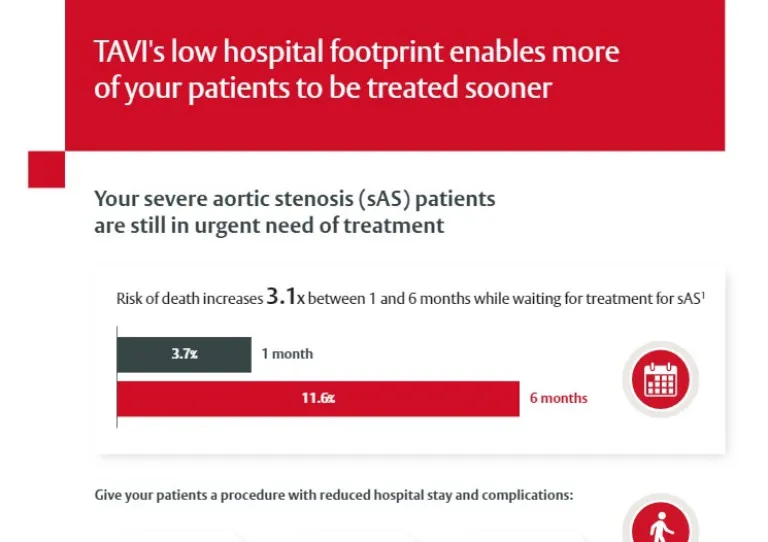- The most common treatment goal defined by symptomatic severe aortic stenosis (ssAS) patients is an improvement in Quality of Life (QoL)1
- TAVI can help your ssAS patients achieve treatment goals that matter the most to them1-6
- TAVI has demonstrated faster recovery compared to surgery as well as a rapid return to daily activities2,3
Patients seek QoL improvement as the primary treatment goal1
93% of patients who underwent TAVI said improved QoL was their primary treatment goal. Patients favoured the ability to enjoy their regular activities and spend time with loved ones over goals relating to heart failure symptomatology: *
Improvements in quality of life with TAVI 1

* Data on primary quality of life goals for 46 high-surgery risk AS patients who chose TAVI over medical treatment or palliative care.
† The expanded pie chart only represents the 93% who expressed a QoL goal as their primary goal.
TAVI offers patients a rapid return to daily activities2
A return to daily activities is the most frequently reported goal of treatment followed by maintaining or improving independence.1 TAVI demonstrated a greater improvement of patient-defined goals at 30 days compared with surgery:2‡
Change in percentage of patients without symptoms or activity limitations at 30 days2

‡ The PARTNER II Trial intermediate-risk cohort unadjusted rates, as-treated population (n=1,818). Showing representative questions of daily life activities from EuroQol-5D (EQ-5D) and short form KCCQ-12. The graph represents select categories, other daily life activities from EQ-5D and KCCQ-12. Activities captured by these quality of life measures include: hobbies or recreational activities, visiting family or friends out of their home, hurrying or jogging (as if to catch a bus) and the frequency of: shortness of breath, sleeping sitting up, and swelling in feet, ankles or legs upon waking.
§ Patients reporting “limited for other reasons or did not do the activity” were not included in the analysis.
TAVI demonstrates early and sustained QoL benefits in all risk group3,6
Data from the PARTNER 3, II S3i, 1A and 1B Trials show that patients receiving TAVI enjoyed a better health status post-procedure compared to control group (sAVR or standard treatment), as measured using the Kansas City Cardiomyopathy Questionnaire (KCCQ).
In low-risk ssAS patients, SAPIEN 3 TAVI provided substantially improved health status at 1 month (16.0 points; 95% CI 14.2 to 17.8; p<0.001), 6 months (2.6 points; 95% CI 1.0 to 4.3; p=0.002) and 1 year (1.8 points; 95% CI 0.1 to 3.5; p=0.033) compared to sAVR:3
KCCQ overall summary (OS) score

Adapted from Baron SJ et al. 2019.
See the full evidence for TAVI in low-risk sAS patients
In intermediate-risk patients, SAPIEN 3 TAVI provided substantially improved health status at 1 month (15.6 points; 95% CI 13.7 to 17.5; p<0.001) and 12 months (2.0 points; 95% CI 0.1 to 3.8; p=0.039) compared to sAVR:4
KCCQ overall summary (OS) score:

Adapted from Baron SJ et al. 2018. Data from the PARTNER II S3i Trial.
See the full evidence for TAVI in intermediate-risk ssAS patients
In high-risk patients, TAVI provided substantially improved health status at 1 month (9.9 points; 95% CI 4.9 to 14.9; p<0.001) compared to sAVR:5
KCCQ overall summary (OS) score

Adapted from Reynolds MR et al. 2012.
See the full evidence fo TAVI in high-risk ssAS patients
In inoperable patients, TAVI provided substantially improved health status at 1 month (13.3 points; 95% CI 7.6 to 19.0; p<0.001), 6 months (20.8 points; 95% CI 14.7 to 27.0; p<0.001), and 12 months (26.0 points; 95% CI 18.7 to 33.3; p<0.001) compared to standard therapy:6
KCCQ overall summary (OS) score

Adapted from Reynolds MR et al. 2011.
See the full evidence for TAVI in inoperable ssAS patients
Clinical implications
What could a TAVI referral mean for your ssAS patients?
- Health status benefits that matter most to them1
- A speedy recovery compared to surgery so they can get back to the life they love3-6
- Meaningful, early and late health status benefits which could give your patients the opportunity for a fuller life3-6
References:
1 Coylewright M. et al. Health Expect. 2016;19(5):1036-1043.
2 Datos en archivo de Edwards.
3 Baron SJ, et al. J Am Coll Cardiol. 2019;74(23):2833–2842.
4 Baron SJ, et al. JACC: Cardiovascular Interventions. 2018;11(12):1188-1198.
5 Reynolds MR, et al. J Am Coll Cardiol 2012;60:548–558.
6 Reynolds MR, et al. Circulation. 2011;124:1964-1972.
Medical device for professional use. For a listing of indications, contraindications, precautions, warnings, and potential adverse events, please refer to the Instructions for Use (consult eifu.edwards.com where applicable).
PP--EU-0774 v2.0
